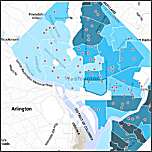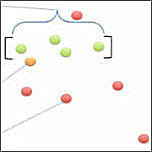A theme running through many of our popular articles published this year is the need to use data in ways that truly engage beneficiary communities, social sector organization leaders, and social impact investors and funders.
Articles also highlight the importance of language in engaging these groups. They explore how terms such as “nonprofit,” “overhead,” and “social entrepreneur” can greatly affect perceptions of social sector work, and suggest new, potentially more helpful ways of framing these ideas.

1. Community Engagement Matters (Now More Than Ever)
In their desire to maximize efficiency, leaders of data-driven programs often operate in a top-down manner and see community engagement as an “extra” that can detract from “what works.” In this article, Melody Barnes and Paul Schmitz show how meaningful, sustained engagement with communities actually strengthens evidence-based practice.

2. Five Myths That Perpetuate Burnout Across Nonprofits
Reflecting on her own experiences working at nonprofits, Ann-Sophie Morrissette identifies five common nonprofit practices that perpetuate what she calls the “burnout/re-ignition cycle.” These include the idea that colleagues are like family, which can blur important lines between professional and personal life, and that higher pay doesn’t matter much, an issue no less relevant than when SSIR published “The Nonprofit Starvation Cycle” in 2009.

Are you enjoying this article? Read more like this, plus SSIR's full archive of content, when you subscribe.
3. Tackling Heropreneurship
In this article, Daniela Papi-Thornton argues that the social sector’s current focus on individual, heroic social entrepreneurs—“heropreneurs”—is taking vital attention and funding away from approaches that are more collaborative, or more firmly rooted in personal experience and understanding. “All too often, the people who get the funding to try their hand at solving global challenges haven’t lived those problems themselves,” she writes. The discussion continues in SSIR’s ongoing series inspired by the article.

4. Three Things Great Data Storytellers Do Differently
There are lots of ways to assemble data into charts, maps, or other kinds of visualizations, but some are going to resonate more than others. In this article, a follow-up to his talk at SSIR’s Data on Purpose conference, Jake Porway suggests that the best data storytelling helps us see the forest as well as the trees.

5. Pay-What-It-Takes Philanthropy
In this Up for Debate article, authors from The Bridgespan Group argue that funders need to shift from funding programs and services to funding a nonprofit’s overall costs, including what’s often dismissed as “overhead.” The authors suggest that as foundations get used to the idea of “paying what it takes,” they might determine appropriate levels of funding by segmenting nonprofits based on type and then setting benchmarks within each segment. Eleven nonprofit and foundation leaders and experts published responses to the article.

6. Is It Time to Ditch the Word “Nonprofit”?
In this controversial article, Allison Gauss argues that just as the term for a social sector organization transitioned from “charity” to “nonprofit” in the 20th century, it’s now time to find a new term. “What you call yourself is a signal, not only to others, but also to yourself, of what you are capable of,” she writes. “Giving social good organizations a more fitting title could energize the sector, and spur greater innovation and ambition.”

7. Redesigning American High Schools for the 21st Century
“Research tells us that teenagers pay attention better when they sleep in later, move more during the day, and have shorter hours of direct lecture,” writes Patrick Cook-Deegan. And yet current schools offer the opposite. His suggestions include rethinking school days’ structure, creating better physical spaces, and expanding teaching beyond academics to include social-emotional and practical learning that can help students feel more connected to their work.

8. The Next Frontier in Social Impact Measurement Isn’t Measurement at All
For social capital markets to work well, investors need to be able to effectively compare impact data from across the social sector. But how is this possible when different programs and organizations measure different things? The key, Kate Ruff and Sara Olsen argue, is to ensure that more social impact analysts have the experience and skills needed to compare “apples and oranges.”

9. Using Data for Action and for Impact
Social sector organizations want to ensure that their programs not only operate efficiently, but also lead to lasting impact. To do this, Jim Fruchterman writes, organizations must ask three questions: How much did we spend? How much did we do? And how much did it matter? By answering these questions, in order, he argues social change leaders can gather ever more aggregated types of data and ultimately tackle the toughest question of all: the question of impact.

10. Great Mission. Bad Statement.
“The rampant, widespread use of boring, convoluted language is costing the social sector a lot of money,” writes Erica Mills. “Nonprofits are spending more to get people involved in their cause simply because no one can understand what they’re saying.” In this article, she suggests a few simple strategies that can help nonprofits say what they really mean in a fresh, engaging way.
Support SSIR’s coverage of cross-sector solutions to global challenges.
Help us further the reach of innovative ideas. Donate today.
Read more stories by Justine Drennan.

